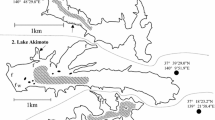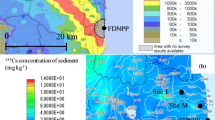Abstract
In 1989, three years after the disaster at Chernobyl, the Cesium (Cs-137 and Cs-134) activity of water, sediments, suspended solids, algae, and crustaceans were studied in five sections of the Weser estuary covering the nontidal and tidal freshwater region down to the brackish area. The total water activities in the freshwater regions are similar, but there are differences in the Cs distribution between the dissolved and the particulate phase depending on the concentration of suspended solids and abiotic water parameters. The Cs activity derived from Chernobyl is only detectable in sediments and suspended solids. Specific differences in Cs accumulation were found for crustaceans but not for algae.
Similar content being viewed by others
References
AARKROG, A., 1988. The radiological impact of the chernobyl debris compared with the nuclear weapons fallout. J. Environ. Radioactivity. 6: 151–162.
ARGE ELBE (Arbeitsgemeinschaft für die Reinhaltung der Elbe). 1985. Radioaktivitätswerte der Elbe. Von Schnakenburg bis zur See.
ASTON, S.R. and E.K. DUURSMA, 1973. Concentration effects on137Cs.65Zn.60Co and106Ru sorption by marine sediments, with geochemical implications. J. Sea Res., 6: 225–240.
AURAND, K., 1982. Radioökologie und Strahlenschutz. E. Schmidt Verlag, Berlin.
BAUMGARTNER, D. and W. HERZER, 1987. Vorstudie Nuklidmeßprogramm Weser. Teil 1. Vorstudie Nuklidmeßprogramm Weser. Teil 2. Universität Bremen (unpublished).
BMU (BUNDESMINISTER FÜR UMWELT, NATURSCHUTZ UND REAKTORSICHERHEIT), 1984. Umweltpolitik, Umweltradioaktivität und Strahlenbelastung. Jahresbericht 1984.
BMU (BUNDESMINISTER FÜR UMWELT, NATURSCHUTZ UND REAKTORSICHERHEIT), 1985. Umweltpolitik, Umweltradioaktivität und Strahlenbelastung. Jahresbericht 1985.
BMU (BUNDESMINISTER FÜR UMWELT, NATURSCHUTZ UND REAKTORSICHERHEIT), 1986. Umweltpolitik, Umweltradioaktivität und Strahlenbelastung. Jahresbericht 1986.
BRYAN, G.W., 1963. The accumulation of caesium-137 by brackish water invertebrates and its retention to the regulation of potassium and sodium. J. Mar. Biol. Ass. UK., 43: 541–565.
DHI (DEUTSCHES HYDROGRAPHISCHES INSTITUT), 1987. Die Auswirkungen des Kernkraftwerkunfalles von Tschernobyl auf Nord- und Ostsee. Meereskundliche Beobachtungen und Ergebnisse Nr. 62. Hamburg.
DUURSMA, E.K. and D. EISMA, 1973. Theoretical, experimental and field studies concerning reactions of radioisotopes with sediments and suspended particles of the sea. Part C. Applications to field studies. Neth. J. Sea. Res., 6: 265–234.
FELDT, W. and G. KANISCH, 1985. Die Entwicklung der radioaktiven Kontamination der Nordseefische und der Flußunterläute von Elbe und Weser. In: Strahlenexposition der Bevölkerung. 18. Jahrestagung des Fachverbandes für Strahlenschutz eV. 06–10. Oktober 1985 in Lübeck-Travemünde. FS-85-37-T. p. 598–606.
FELDT, W., G. KANISCH, H.-J. KELLERMANN and M. VOBACH, 1990. Radioökologische Studien an der Unterweser. Berichte aus dem Isotopenlaboratorium der Bundesforschungsanstalt für Fischerei. ISSN 0720-6046. Heft 6, Hamburg.
HAESLOOP, U., 1990. Beurteilung der zu erwartenden Auswirkungen einer Reduzierung der anthropogenen Weserversalzung auf die aquatische Biozönose der Unterweser. Dissertation. Universität Bremen.
KNÖTZEL, J., H. LUHMANN, P.C. RATHCKE, A. WEDEMEYER and F. WICHMANN, 1980. Die Verbreitung von Gammarus tigrinus SEXTON in der Unterweser und in ihren wichtigsten Nebenflüssen. Arbeitsvorhaben des Projektes ‘Weserwasser’. Universität Bremen (unpublished).
KOLEHMAINEN, S.E., E. HÄSÄNEN and J.K. MIETTINEN, 1967. 137-Cs in fish, plankton and plants in finnish lakes during 1964–1965. In: B. Arberg and F.P. Hungate, Eds., Radioecological concentration processes-Proceed. of an intern. symp. held in Stockholm. 1966. Pergamon Press; p. 913–919.
KORNEMANN, P. and P.-H. SAHLING, 1977. Meeresalgen von Helgoland. Helgoländer wissenschaftl. Meeresuntersuchungen 29: 1–289.
MUNDSCHENK, H., 1985. Über das Austauschverhalten von Radionukliden an Schwebstoff/Sediment des Rheins. Dt. Gewässerk. Mitt., 1: 4–13.
MURRAY, C.N. and C. MURRAY, 1973. Adsorption-desorption equilibria of some radionuclides in sediment-fresh-water and sediment-seawater systems. In: Proceedings of a symposium on the interaction of radioactive contaminants with the constituents of the marine environment. International Atomic Energy Agency (IAEA), Vienna, p. 105–122.
NIES, H., 1990. Radioaktive Substanzen. In: L.J. Lozan, W. Lenz, E. Rachor, B. Watermann and H. Westernhagen, Eds., Warnsignale aus der Nordsee. Wissenschaftliche Fakten. Verlag Paul Parey, Berlin, p. 87–100.
NLW (NIEDERSÄCHSISCHES LANDESAMT FÜR WASSERWIRTSCHAFT), 1985. Bericht über die Untersuchung im Rahmen der Beweissicherung-Beweissicherung KK Unterweser-Radioaktivitätsdaten der Unterweser 1972–1984. Berichterstatter: Chemierat Dr. Städe. Hildesheim.
PENTREATH, R.J., D. CALMET, P.M. GUEGUENIAT, B. PATEL and S. PATEL, 1985. Behaviour of radionuclides released into coastal waters. Tech. Doc. IAEA, Vienna (329).
SCHUCHARDT, B. and M. SCHIRMER, 1990. Diatom frustules as natural tracers to determine the origin of suspended matter in the Weser estuary. Environ. Technol., 11: 853–858.
STRAHLENSCHUTZKOMMISSION (SSK), 1988. Radionuklide in Wasser-Sedwebstoff-Sediment-Systemen und Abschätzungen der Strahlenexposition. BMU. Veröffentlichungen der SSK Band 9. Gustav Fischer Verlag. Stuttgart.
WRENN, D.E., J.W. LENTSCH and M. EISENBUD, 1971. Radiocesium distribution in water, sediment, and biota in the Hudson River estuary from 1964 through 1970. In: D. J. Nelson. Ed., Proc. Third Symp. on Radioecology. Vol 2, Oak Ridge, Tennessee, p. 144–151.
Author information
Authors and Affiliations
Rights and permissions
About this article
Cite this article
Rieger, E.M., Claus, B., Schirmer, M. et al. Cesium isotope-activity in the Weser ecosystem three years after the disaster at Chernobyl. Netherlands Journal of Aquatic Ecology 27, 197–203 (1993). https://doi.org/10.1007/BF02334783
Issue Date:
DOI: https://doi.org/10.1007/BF02334783




